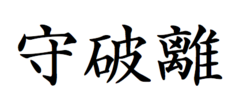
Shuhari: roughly translates to "first learn, then detach, and finally transcend."
• shu (守?) "protect", "obey" — traditional wisdom — learning fundamentals, techniques, heuristics, proverbs
• ha (破?) "detach", "digress" — breaking with tradition — detachment from the illusions of self
• ri (離?) "leave", "separate" — transcendence — there are no techniques or proverbs, all moves are natural, becoming one with spirit alone without clinging to forms; transcending the physical
Definition
Aikido master Endō Seishirō shihan stated:
"It is known that, when we learn or train in something, we pass through the stages of shu, ha, and ri. These stages are explained as follows. In shu, we repeat the forms and discipline ourselves so that our bodies absorb the forms that our forbearers created. We remain faithful to the forms with no deviation. Next, in the stage of ha, once we have disciplined ourselves to acquire the forms and movements, we make innovations. In this process the forms may be broken and discarded. Finally, in ri, we completely depart from the forms, open the door to creative technique, and arrive in a place where we act in accordance with what our heart/mind desires, unhindered while not overstepping laws."[1]
History
The Shuhari concept was first presented by Fuhaku Kawakami as Jo-ha-kyū in Tao of Tea. Then, Zeami Motokiyo, the master of Noh, extended this concept to his dance as Shuhari, which then became a part of the philosophy of Aikido.[citation needed] Shuhari is part of the philosophy of Shorinji Kempo.
Shuhari can be considered as concentric circles, with Shu within Ha, and both Shu and Ha within Ri. The fundamental techniques and knowledge do not change.[2]
During the Shu phase the student should loyally follow the instruction of a single teacher; the student is not yet ready to explore and compare different paths.[3]
